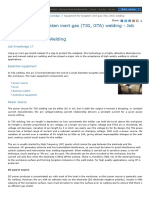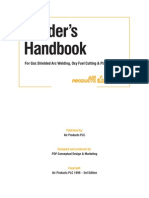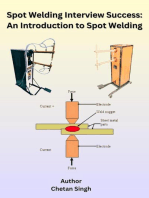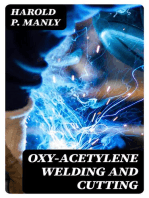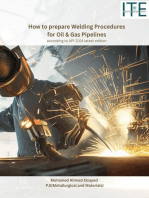Bolted Aluminium Terminal Connectors For Substations: Material of Castings
Bolted Aluminium Terminal Connectors For Substations: Material of Castings
Uploaded by
Travis WoodCopyright:
Available Formats
Bolted Aluminium Terminal Connectors For Substations: Material of Castings
Bolted Aluminium Terminal Connectors For Substations: Material of Castings
Uploaded by
Travis WoodOriginal Description:
Original Title
Copyright
Available Formats
Share this document
Did you find this document useful?
Is this content inappropriate?
Copyright:
Available Formats
Bolted Aluminium Terminal Connectors For Substations: Material of Castings
Bolted Aluminium Terminal Connectors For Substations: Material of Castings
Uploaded by
Travis WoodCopyright:
Available Formats
BOLTED ALUMINIUM TERMINAL CONNECTORS FOR SUBSTATIONS Applicable standard:IS 5561-1970 Connector design concepts: 1.
0 The temperature rise of the connector shall not exceed the temperature rise of the conductor with which it is intended to be used. The temperature rise of an electrical connector which connects conductors of different sizes shall not exceed the temperature rise of the conductor having the highest temperature rise. All the temperatures are based on conductor being rated at 30 degree rise above a 40 degree ambient,indoors, in still but unconfined air. 2.0 Connector sections should be heavy enough to carry electrical loads and to withstand forces applied during installation as well as during service life or short circuit, expansion and contraction due to temperature variations, vibration etc. Actually, the greatest mechanical stress that a connector is subjected to occurs during the installation and if the connector is properly designed to withstand this stress, it will be normally capable of withstanding any other force to which it is subjected to. 3.0 Connector should be easy to install. This would reduce installation time and ensure that it will be properly installed. 4.0 Connector should be able to withstand the environmental corrosion, particularly in case of proximity to marine, industrial and chemical environments. 5.0 The current path in the conductor should be as short and direct as possible. 6.0 Conductor design should avoid crevices to prevent retention of water. 7.0 Pressure applied through bolts shall be well distributed over the clamping surface. 8.0 In case of copper-aluminium connectors, the aluminium member should never be positioned in such a way that would allow water to drain from the copper connector over (or onto) the aluminium connection point. Copper salts affect aluminium but not vice versa. In other words, aluminium should always be placed above copper and not vice versa. Material of castings: LM6 LM25 Aluminium alloy 356 (with 7% Si and 0.3% Mg ) is not susceptible to stress corrosion and season cracking and is heat treated to T6 condition Filler Rod: Aluminium Alloy of dia Shielding gas: Argon Welding apparatus:TIG/MIG A 400A machine with reverse polarity Production and testing facilities; Design software: Autocad,CAD/CAM to integrate product design/Finite Element Analysis/Surface Modeling Pattern shop Tool Room with fixtures,jigs,dies and production tools Aluminium melting furnace with continuous temperature recording facility Multiple moulding stations for flexibility of operation and optimum cast quality Metallurgical laboratory for Microtructure
Spectrometer for chemical analysis of aluminium and SQC for regulating metal chemistry Tensile and Hardness Tester for physical properties of aluminium alloy Sand laboratory for properties measurement Gas Porosity check for molten aluminium Machine shop with drill presses, lathes, milling machines,CNC turning machines Vibratory finishing to remove flash and produce a smooth burr-free surface Bench assembly stations Heavy duty storage racks for Raw material and finished goods Temperaure Rise test facility Tensile /Pull Test facility Digital micro-ohm meter for Low resistance measurement Galvanising Test facility with running water basin for Preece Test Elcometer for measurement of zinc coating Hammer for adhesion test Vernier calipers,scales,measuring tape Welders Qualification: Welder shall be qualified to perform TIG/MIG welding.Men with experience in metal welding shall be trained for aluminium welding for a miimum peiod of one week. The important points to be considered are a) type of welding equipment, whether watercooled or not.If welding currents of more than 125A are required,watercooling is to be provided to the electrode holder and the welding gun. b) Position of the weld c) Operators skill level d) Use of proper shields: The arc in TIG/MIG welding is approximately twice as strong as standard AC welding arc.Extreme care is to be taken for protection of eyes. Preparation of aluminium members for welding: It is of utmost importance to remove oil, grease, water and oxide from the surfaces to be welded.All the surfaces to be welded should be wirebrushed with stainless steel wire brush prior to welding.The stainless steel brushes are specified because stainless steel has less of a tendency to pick up particles of aluminium oxides.If more than one weld pass is required, then original weld is to be wirebrushed before applying additional weld. Preheating of the surfaces to 220 degrees C before welding is optional, but it helps the operator to weld easily and faster. Need for only TIG/MIG welding for aluminium connectors: Pure aluminium melts at 1220 degrees F whereas aluminium alloys melt in the range of 1020 degrees F.When aluminium alloys are heated there is no colour change.Hence, it is difficult, if not impossible to tell if the temperature is near the welding temperature. The everpresent surface oxide film on aluminium has a melting point of 3600 degrees F.The parent aluminium alloy can therefore be melted without fusing the surface oxides.Unless the film is removed,cleanliness of the molten filler material and parent metal cannot be complete and both strength and conductivity will be sacrificed.Therfore, it is of paramount importance to remove aluminium oxides from aluminium ally before
welding is started,In the shielded arc welding method, the shielding gas has a tendency to clean the material as welding progresses. TIG welding:The inert gas shielded tungsten arc welding is widely used for welding aluminium bus fittings.In this process, the arc is established between a non-consumable tungsten electrode and the section to be welded.Inert gas envelopes the arc to prevent oxidation. Hence, no flux is required.A bare filler rod supplies filler material to weld area.To initiate the arc the tungsten electrode is placed in contact ith the component and withdrawn to establish an arc length of about 5mm.The arc is given a circular motion until the base metal liquefies and a weld puddle is established.Filler material is added by hand as required.If more than one pass is required for sufficient weld the weld hould be wirebrushed between passesto remove any surface dirt or oxides which has accumulated from the previous pass.Since no flux is used, finished flux does not need any cleaning.In this process, the heat of tungsten arc is concentrated in a small area.Hence welding is faster and distortion of the weld is also negligible.If thickness of more than 12mm is to be welded, preheating of parts before welding increases welding speed. TIG WELDING PARAMETERS IPS Wall Amp. Gas size/Flat thickness cup bar dia. thickness Tungsten dia Argon flow rate Preheat No.of Filler passes rod size
MIG welding: MIG welding combines the advantages of TIG welding with increased speed of welding.Welding can be done in any position, in either manual/automatic mode.In bare filler rod is supplied as a coil of bare wire.In some commercial models, the wire is added to the weld at a predetermined rate by a motor-driven feed based on the magnitude of welding current.Either helium, or Argon or a mixture of these gases is used for shielding.Pure Argon is used for sections less than 18mm thick.On sections over 18mm thick,the gases are mixed to combine the hotter arc characteristics of helium with the stabilizing effect of Argon.If exceptionally hot arc characteristics are needed,pure helium can be substituted for the gas mixture.However, precaution is to be exercised as it is very easy to burn through the items that are to be welded in a helium atmosphere. TIG WELDING PARAMETERS IPS Wall Amp. Filler size thickness Rod wire Argon flow rate Preheat Wire speed No. of passes
Choice of Hardware The hardware material that is generally supplied with bolted connectors is in keeping with the concept of avoidance of dissimilar metals to reduce electrolytic and other corrosion.The standard hardware on aluminium alloy connectors is anodized aluminium hardware.However, stainless steel/Galvanised steel hardware is used for aluminium alloy connectors.In case stainless steel hardware is used, anti-seize lubricant is to be applied. Hardware for joining like or unlike metals
A BAR B BAR Recommended Series of hardware
Copper Copper Silicon Bronze SS GS
Aluminium Copper SS GS
Aluminium Aluminium Al SS GS
Galv.Steel Copper Silicon Bronze SS GS
Galv.steel Aluminium Al SS GS
Steps for assembly of bolted aluminium connectors: a) All contact surfaces of the connector shall be vigorously cleaned with a stiff stainless steel brush to remove oxides.A typically bright aluminium surface is to be obtained.Bimetallic plates are not to be wirebrushed,However, scotchbrite may be used to clean them. b) Immediately, a liberal amount of sealant is to applied to the contact areas. c) Connecor is to be assembled with bolts finger tight.If a generous bead of sealant does not appear, open the assembly and add more sealant. d) The bolts are to be tightened alternately(criss-cross)and evenly with a torque wrench to the recommended torque as given in the table below. e) Excess sealant squeezed out of joint can be left as is or can be lightly smoothed along the contact line. f) All excess sealant must be removed from EHV connectors due to corona problem. Bolt tightening Torques: Sl.no 1 2 3 Bolt diameter M 10 M12 M16 Torque 27.17N-m 54.44N-m 74.75N-m
Galvaniccorrosiondueto joiningof dissimilarmetals When a condition causing electrolysis exists, one of the two dissimilar metals becomes the anode and the other becomes the cathode. To determine which metal will become the anode and which will become the cathode refer to the Galvanic Series table in this section. The metal listed with the most relatively positive voltage is the cathode and the metal with the relatively more negative voltage is the anode. When electrolysis is taking place the anode gives off some of its molecules to the cathode. After the period of time that this action has taken place the anode eventually has no more molecules to give off. This is sometimes called galvanic corrosion. When this occurs with an electrical connector, failure eventually results. By understanding how various factors can influence electrolysis on electrical connections made with dissimilar metals, its corrosive effects can be minimized. Electrolysis Factors
1. Voltage The higher the relative voltage difference of the two different metals the faster the anode will deteriorate or corrode. By keeping the relative voltage between the two metals on the Galvanic Series table to a minimum, corrosion of the anode slows down. Using the Galvanic Series table for example we find that copper has a relative voltage of -0.20 volts. On the same table aluminum has a relative voltage of -0.80. Therefore the relative voltage between the two metals is the difference between copper and aluminum, or about -0.60 volts (difference between -0.20 and -0.80). Notice that tinplate has a relative voltage of -0.50 volts. By plating one of the metals the relative voltage can be reduced to -0.30 volts. 2. Anode size Relative physical size of the anode to that of the cathode in an electrical connection can contribute to the life expectancy of the connection. Since the anode will be giving off molecules to the cathode it stands to reason that when the mass of the anode is significantly greater than that of the cathode its life expectancy of the connection is improved. 3. Environment The Galvanic Series table uses salt water. A change in the environment that the two metals used in making the electrical connection can also change the effects of galvanic corrosion. www.sbiconnect.es 35
de Subestacin Raccords de Poste
You might also like
- Book of Welding 2007Document80 pagesBook of Welding 2007Gangadhar Yeddala50% (2)
- Weld Like a Pro: Beginning to Advanced TechniquesFrom EverandWeld Like a Pro: Beginning to Advanced TechniquesRating: 4.5 out of 5 stars4.5/5 (6)
- PGCIL GIS Specification - Rev 4 (June-14)Document74 pagesPGCIL GIS Specification - Rev 4 (June-14)Travis Wood100% (1)
- Azing Procedure Weld Copper WaterstopDocument5 pagesAzing Procedure Weld Copper Waterstopzhuxueyun55No ratings yet
- Presentation On: Applications of and Welding in ManufacturingDocument27 pagesPresentation On: Applications of and Welding in ManufacturingHope ThemNo ratings yet
- Equipment For Tig WeldingDocument4 pagesEquipment For Tig WeldingSaeedNooriNo ratings yet
- Welding of Nickel AlloysDocument4 pagesWelding of Nickel AlloysMuhammed SulfeekNo ratings yet
- Analysis of Tig Welding Weldment and Defect Identification Using Non Destructive Testing NDTDocument48 pagesAnalysis of Tig Welding Weldment and Defect Identification Using Non Destructive Testing NDTRebecca KelleyNo ratings yet
- P20 Tool Steel-Welding-Spec PDFDocument8 pagesP20 Tool Steel-Welding-Spec PDFMICKENo ratings yet
- Aluminium GMAW WeldingDocument34 pagesAluminium GMAW Weldingcentaury2013No ratings yet
- WTDocument299 pagesWTrsarunprasathNo ratings yet
- welding-2Document28 pageswelding-2devadityavikram3No ratings yet
- SS 409M WeldingDocument12 pagesSS 409M WeldingwentropremNo ratings yet
- Job Knowledge 17Document4 pagesJob Knowledge 17Mehmet SoysalNo ratings yet
- Fundamentals MIG WeldingDocument3 pagesFundamentals MIG WeldingSreejith MenonNo ratings yet
- Bohler - Manual de Reparatii Prin SuduraDocument53 pagesBohler - Manual de Reparatii Prin Suduracostelino72100% (1)
- Gas Metal Arc Welding (GMAW)Document16 pagesGas Metal Arc Welding (GMAW)Akmal Bin Saipul AnuarNo ratings yet
- Arc WeldingDocument27 pagesArc WeldingravirainbowNo ratings yet
- How To Weld 254 SMO PDFDocument12 pagesHow To Weld 254 SMO PDFPrabhakar KattulaNo ratings yet
- Welding MachineDocument3 pagesWelding MachinetuanNo ratings yet
- Welding Process SeminarDocument14 pagesWelding Process Seminartemporary hNo ratings yet
- Orbital-Welding Facts enDocument52 pagesOrbital-Welding Facts ene.vicente.caballeroNo ratings yet
- Welding: Philippine Society of Mechanical Engineers Professional Development CourseDocument30 pagesWelding: Philippine Society of Mechanical Engineers Professional Development CourseAngel Silva VicenteNo ratings yet
- Welding Questions and AnswersDocument6 pagesWelding Questions and Answersengrzia76No ratings yet
- Final Welding of Ti Alloys and MG AlloysDocument32 pagesFinal Welding of Ti Alloys and MG AlloysArjyajyoti GoswamiNo ratings yet
- Magnesium JoiningDocument4 pagesMagnesium Joiningst_anbu9650No ratings yet
- Welding NPTEL Lecturers - Part4Document30 pagesWelding NPTEL Lecturers - Part4Sai ChaithanyaNo ratings yet
- Weld 2507Document8 pagesWeld 2507kyaw369No ratings yet
- Gmaw PDFDocument34 pagesGmaw PDFGnanasekaran MNo ratings yet
- JJ205 Workshop Technology Tic&Mic WeldingDocument47 pagesJJ205 Workshop Technology Tic&Mic WeldingAh TiangNo ratings yet
- Sheet Metal Welding-Tips PDFDocument5 pagesSheet Metal Welding-Tips PDFMphilipTNo ratings yet
- Documents - Pub - Advanced Welding TechnologyDocument60 pagesDocuments - Pub - Advanced Welding TechnologybalamuruganNo ratings yet
- Weldingbasics SetDocument13 pagesWeldingbasics SetBruce WeathersNo ratings yet
- Critical To Quality in Welding-1Document29 pagesCritical To Quality in Welding-1aadmaadmNo ratings yet
- TIG Welding: Job KnowledgeDocument3 pagesTIG Welding: Job KnowledgeRakesh Kumar Munda100% (1)
- Welder's Handbook (Air Products Co.)Document48 pagesWelder's Handbook (Air Products Co.)Patrick DominguezNo ratings yet
- Engineering Welding Handbook99 PDF TigDocument48 pagesEngineering Welding Handbook99 PDF TigSorin Stanescu100% (1)
- Welding Procedure SpecificationDocument5 pagesWelding Procedure SpecificationyazNo ratings yet
- Types of WeldingDocument66 pagesTypes of WeldingLee Shi HongNo ratings yet
- Welding of Tool SteelDocument17 pagesWelding of Tool SteelwasserbombNo ratings yet
- Welding of Tool Steel - Uddeholm (Ebook, 17 Pages)Document17 pagesWelding of Tool Steel - Uddeholm (Ebook, 17 Pages)Ismael 8877No ratings yet
- Koco Koco Kocovvv Koco Koco Kocovv Koco KocoDocument0 pagesKoco Koco Kocovvv Koco Koco Kocovv Koco KocoSun SunNo ratings yet
- MIG Vs TIG Vs Stick Vs Flux Core Welding ProcessesDocument8 pagesMIG Vs TIG Vs Stick Vs Flux Core Welding ProcessesCalvin YeohNo ratings yet
- Welding MachinesDocument53 pagesWelding MachinesDeepak Kumar Kant Kesri100% (2)
- Welding EngineeringDocument338 pagesWelding EngineeringMuhammed Sulfeek100% (3)
- Presentation WeldingDocument18 pagesPresentation Weldingjoebert agraviadorNo ratings yet
- Gas Tungsten Arc Welding Practice:: Jobs 19-J1-J19 (Plate)Document8 pagesGas Tungsten Arc Welding Practice:: Jobs 19-J1-J19 (Plate)Willy UioNo ratings yet
- Guide To Aluminium WeldingDocument3 pagesGuide To Aluminium WeldingManish SharmaNo ratings yet
- Welding Tips & Tricks: All you need to know about welding machines, welding helmets, and welding gogglesFrom EverandWelding Tips & Tricks: All you need to know about welding machines, welding helmets, and welding gogglesRating: 1 out of 5 stars1/5 (1)
- Welding Terminology: A Guide to MIG, TIG, Stick, Gas, and Spot Welding TermsFrom EverandWelding Terminology: A Guide to MIG, TIG, Stick, Gas, and Spot Welding TermsNo ratings yet
- Spot Welding Interview Success: An Introduction to Spot WeldingFrom EverandSpot Welding Interview Success: An Introduction to Spot WeldingNo ratings yet
- Oxy-Acetylene Welding and Cutting Electric, Forge and Thermit Welding together with related methods and materials used in metal working and the oxygen process for removal of carbonFrom EverandOxy-Acetylene Welding and Cutting Electric, Forge and Thermit Welding together with related methods and materials used in metal working and the oxygen process for removal of carbonNo ratings yet
- Oxy-Acetylene Welding and Cutting: Electric, Forge and Thermit Welding together with related methods and materials used in metal working and the oxygen process for removal of carbonFrom EverandOxy-Acetylene Welding and Cutting: Electric, Forge and Thermit Welding together with related methods and materials used in metal working and the oxygen process for removal of carbonNo ratings yet
- Soldering Electronic Components 2nd EditionFrom EverandSoldering Electronic Components 2nd EditionRating: 3 out of 5 stars3/5 (2)
- Bolted Flanged Joint: Flanges, Studs & Gaskets. Recommended Practices for the Assembly of a Bolted Flange Joint.From EverandBolted Flanged Joint: Flanges, Studs & Gaskets. Recommended Practices for the Assembly of a Bolted Flange Joint.No ratings yet
- The Art of Lead Burning: A practical treatise explaining the apparatus and processesFrom EverandThe Art of Lead Burning: A practical treatise explaining the apparatus and processesNo ratings yet
- How to prepare Welding Procedures for Oil & Gas PipelinesFrom EverandHow to prepare Welding Procedures for Oil & Gas PipelinesRating: 5 out of 5 stars5/5 (1)
- The Art of Lead Burning: A practical treatisening the apparatus and processesFrom EverandThe Art of Lead Burning: A practical treatisening the apparatus and processesNo ratings yet
- Ehv Disconnectors For Smart GridDocument2 pagesEhv Disconnectors For Smart GridTravis WoodNo ratings yet
- 1363 Bolts and Nut Standard PDFDocument7 pages1363 Bolts and Nut Standard PDFTravis WoodNo ratings yet
- KSEB Technical SPec PDFDocument279 pagesKSEB Technical SPec PDFTravis WoodNo ratings yet
- Effect of Grading Ring On Voltage Distribution of ArrestorsDocument7 pagesEffect of Grading Ring On Voltage Distribution of ArrestorsTravis WoodNo ratings yet
- Anandaram BaruaDocument1 pageAnandaram BaruaTravis WoodNo ratings yet
- Double Sampling-Wha It Means PDFDocument17 pagesDouble Sampling-Wha It Means PDFTravis WoodNo ratings yet
- Unidirectional Corona RingDocument2 pagesUnidirectional Corona RingTravis WoodNo ratings yet
- Fretting Fatigue in Overhead ConductorsDocument16 pagesFretting Fatigue in Overhead ConductorsTravis WoodNo ratings yet
- CT Grounding To Avoid Nuisance TrippingDocument2 pagesCT Grounding To Avoid Nuisance TrippingTravis Wood100% (3)
- Transformer Factory Assembly Area LayoutDocument55 pagesTransformer Factory Assembly Area LayoutTravis Wood100% (2)
- ElectricalDocument34 pagesElectricalTravis WoodNo ratings yet
- 3 Sec-III-Hardware Fittings & AccessoriesDocument49 pages3 Sec-III-Hardware Fittings & AccessoriesTravis WoodNo ratings yet
- Spacer Damper IssuesDocument5 pagesSpacer Damper IssuesTravis WoodNo ratings yet
- Mud Architecture: I J I R S E TDocument6 pagesMud Architecture: I J I R S E TJazzNo ratings yet
- 400 Puzzles and Answers PDFDocument188 pages400 Puzzles and Answers PDFTravis WoodNo ratings yet
- Anil Agarwal: Research: Mud As A Traditional Building MaterialDocument10 pagesAnil Agarwal: Research: Mud As A Traditional Building MaterialTravis WoodNo ratings yet
- CB Spec SvenskaDocument44 pagesCB Spec SvenskaTravis WoodNo ratings yet
- An Introduction To Conway's Games and NumbersDocument30 pagesAn Introduction To Conway's Games and NumbersSilentSparrow98No ratings yet
- China Claim FinalDocument1 pageChina Claim FinalTravis WoodNo ratings yet
- Al Si Alloys PDFDocument14 pagesAl Si Alloys PDFTravis WoodNo ratings yet
- Aluminium Recycling Process PDFDocument69 pagesAluminium Recycling Process PDFTravis WoodNo ratings yet
- Aluminium Recycling ProcessDocument69 pagesAluminium Recycling ProcessTravis Wood100% (1)



















